If there is one classic perennial that brings elegance and refinement to any garden, it is the rose. This unabashedly romantic plant is an evocative beauty that comes in countless cultivars, each with its own distinctive charms.

This post is your in-depth introduction to growing roses in your own garden. Use the advanced jump below if you are looking for guidance on a specific aspect of planting or maintaining roses, or read on for the full guide to growing roses.
Jump to:
- What Are Roses?
- Different Types of Roses
- Rose Basics
- Where Do Roses Grow?
- Why Grow Roses?
- When Do Roses Bloom?
- How Long Do Roses Bloom?
- When to Plant Roses
- Ideal Growing Conditions for Roses
- How to Plant Roses
- How to Propagate Roses
- How to Care for Roses
- Recommended Planting Combinations for Rose
- Rose Landscaping Ideas
- Recommended Rose Varieties
- Frequently Asked Questions About Growing Roses
- Where to Buy Roses
What Are Roses?
Let’s start with the basics. The name “rose” refers to any plant in the genus Rosa, which is part of Rosaceae, the rose family. This is a large genus containing hundreds of species.
Rose plants are perennials. That means that they bloom in your garden year after year, unlike annuals, which die after only one season.
Roses come in almost every color you can think of, with cultivars numbering in the tens of thousands.
While roses are grown primarily as ornamental perennials in residential and formal gardens, they are also sometimes cultivated to produce culinary products, perfumes, soaps, and other products that make use of their fragrances and flavors.
Of all the flowers you can plant in your garden, roses are some of the blooms most steeped in symbolism.
This page at the University of Michigan explains, “In mythology, the first red roses are said to have arisen from the BLOOD of Adonis for the love of Aphrodite; thus, they have become symbolic of love, and often resurrection. In Christian symbolism, the RED rose stands for the blood shed by Jesus on the CROSS; it has also become a symbol of earthly love, a tradition which continues today. The rose may represent the Virgin Mary, and thus virginity, or fertility and passion. It is beauty and perfection, happiness and grace, yet it is also sensuality and seduction.”
Roses have been valued throughout history, but it might astonish you to learn just how much. The University of Illinois Extension explains, “Roses were in such high demand during the seventeenth century that royalty considered roses or rose water as legal tender, and they were often used as barter and for payments.”
Wow, imagine being able to buy and sell things using roses as currency!
Different colors of roses have different meanings associated with them. White roses, for example, are often featured in bridal arrangements, so they are linked with weddings. But they also are commonly seen at funerals, so they are also associated with death.
When you add roses to your garden, you can choose them based on your climate zone, the colors and growth habit you prefer, and (if you want) the symbolism you want to convey.
Different Types of Roses
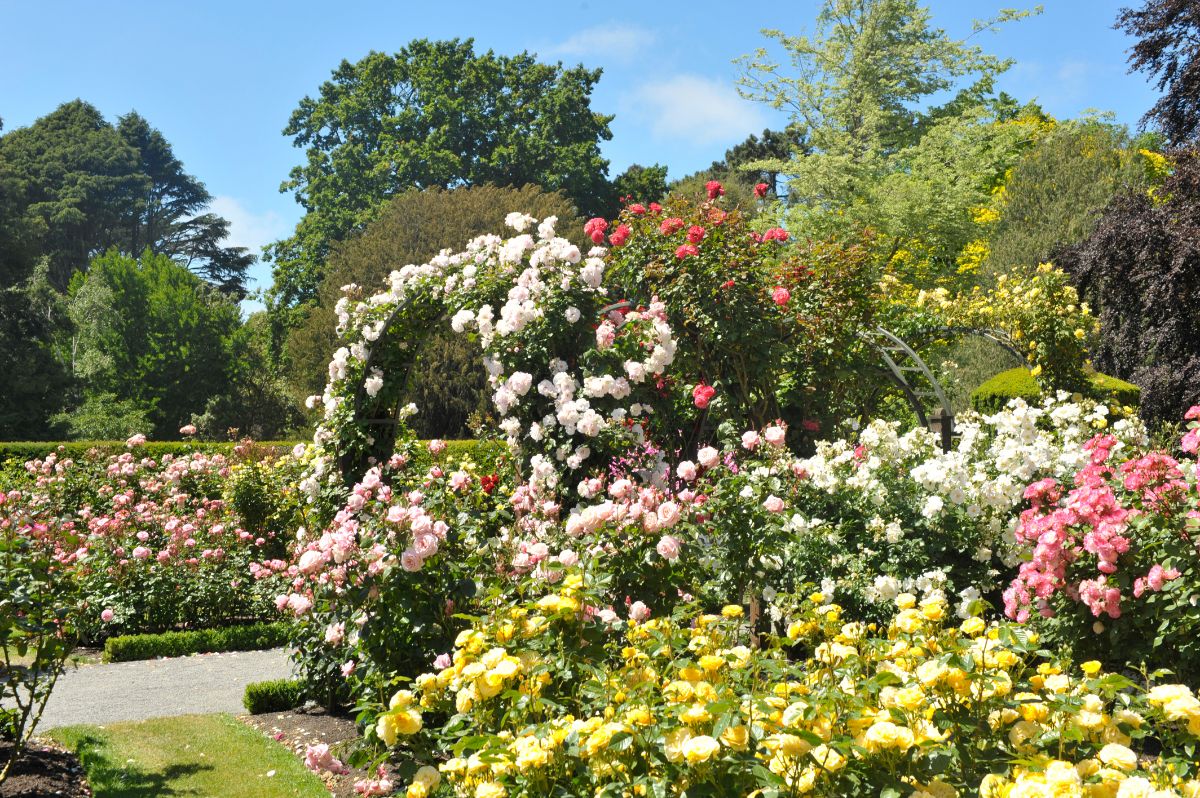
With so much diversity in the Rosa genus, it may not surprise you to learn that there are many different categories of roses. When you are deciding on rose varieties for your garden, it helps to be familiar with these different categories. Below, we share some of the most important categories of roses with you. Keep in mind, however, there may be some additional categories we have not covered.
Main categories of roses:
• Modern roses: If you have to guess what category a rose variety is in, this is usually the correct answer. Modern roses account for the majority of what you are likely to encounter. They can be a bit delicate, which can make them harder to keep healthy than some other types of roses, but they produce sizeable, showy blooms.
• Old garden roses: Roses in this category are also called heritage roses or sometimes historic roses. They date back to before the middle of the 19th century. While modern roses can be repeat bloomers during the growing season, the same is not true for old garden roses. The double blooms they produce are stunning, however, and they are some of the most aromatic roses you can plant.
• Wild roses: Finally, there is the category of wild roses, also referred to as species roses. As you might guess, these roses are wildflowers. While there are a lot of hybrids in the other categories, that is not the case among wild roses. The flowers each feature five petals. While a few colors are possible, the overwhelming majority of wild roses are pink. It would be easy to mistake wild roses for something else since they do not look like the traditional blooms most of us picture when we imagine roses, but they are still beautiful additions to your garden.
Sub-groups of roses
Since you are now familiar with the three overarching categories of roses, we can take a look at some smaller sub-categories.
• Tea roses: This classification refers to Asian cultivars described by the scientific name Rosa x odorata. The origin of the name “tea rose” is a reference to the fragrance of the original tea roses, which reminded people of black tea. The shape of tea roses is very “classic,” and they bloom repeatedly.
• Hybrid tea roses: As the name explains, these are roses that were created by cross-breeding tea roses with other types of roses, originally hybrid perpetuals. Many of the rose cultivars that are popular in residential gardens fall into this category, as their shapes are pleasing, and they are reliable repeat bloomers. There is only one bloom per stem.
• Climbing roses: This is a large category that overlaps with the others on this list and simply refers to any types of roses that have a climbing or rambling growth habit. Some people put “rambling roses” in a different category (a few distinctions can be drawn between them), but many consider the two together. Climbing and rambling roses can grow 20-30 feet tall in some cases.
• Grandiflora roses: While some types of roses in this list date back for hundreds of years, grandiflora roses have only been around since the mid-20th century. Their heyday was between the 50s and 80s, after which they faded somewhat in popularity. They are a cross between floribunda roses and hybrid tea roses. Do not overlook roses in this category, however—they will delight you with their clusters of beautiful blooms as well as their hardiness.
• Polyantha roses: Towards the end of the 19th century, French gardeners crossed Rosa multiflora with Rosa chinensis to create polyantha roses. Plant these types of roses if you need disease-resistant plants that produce numerous small blooms. These roses are fairly hardy and often compact, making some of the best roses in containers.
• Floribunda roses: If you are looking for a cross between a polyantha rose and a hybrid tea rose, check out floribunda roses. These roses have been in existence since the early 20th century. The blooms will remind you of those on hybrid tea roses, but the flowers occur in clusters.
• Miniature roses: This name refers to dwarf grandiflora roses or dwarf hybrid tea roses. They usually measure between 12 and 24 inches tall, though a few get to be up to 36 inches tall. They make ideal container-grown roses for your outdoor space. Resist the urge to try and maintain them as houseplants; they do not usually flourish in indoor conditions, even when the packaging claims they do.
• Canadian hardy: Need to plant some roses that can withstand cold conditions? Look to Canadian hardy roses, which were developed by crossing Rosa arkansana with Rosa rugosa. They can bloom repeatedly, and some can even survive temperature dips as low as -35 degrees Celsius.
• Alba roses: These roses are low maintenance, hardy, and do a great job resisting disease. You will enjoy their attractive blooms as well as their bluish leaves. Given the name “alba,” you might assume that all alba roses are white. Many of them are, but others are pale pink or peach.
• Shrub roses: As you would guess, shrub roses are simply roses that grow as shrubs. As with climbing roses, shrub roses include cultivars from many of the other categories in this list.
• Groundcover roses: These roses max out at a height of 3 feet and have a sprawling growth habit, making them suitable as a groundcover. They bloom repeatedly and are considered easy to grow.
• Bourbon roses: These roses are named for the Île Bourbon, which is where they were created. While the details are a bit foggy, it is likely that gardeners there crossed China roses and Damask roses to develop them. They can climb, and they are celebrated for their gorgeous fragrance.
• Noisettes: These are climbing roses that were originally created in South Carolina by crossing musk roses and China roses.
• Hybrid perpetuals: These roses reached their height of popularity in Victorian Europe. They could sometimes bloom repeatedly, which at the time was quite novel in that part of the world. They also were hardier than tea roses and produced showy flowers that worked well in exhibition settings. They went out of vogue when hybrid tea roses became popular.
• English roses: This is a very informal category of flowers largely established by marketing. These roses are also sometimes called “David Austin” roses, as a reference to the gardener who developed them back in the mid-20th century. The plants bloom repeatedly, like many other modern roses, but have a more traditional appearance. They may make a nice addition to a landscape with a formal English garden style.
• Centifola roses: This category of roses goes by several names. The plants are sometimes called “Provence” roses or “cabbage” roses. As the “cabbage” name suggests, the flowers have a somewhat cabbage-like appearance, making them a unique choice for your garden.
• Damask roses: As you research deeper into these categories, you will notice that Damask roses are often listed in the lineages of other types of roses. This is because Damask rose has been around for many centuries. They are beloved for their fragrances and rainbow of hues. You can find Summer Damask roses and Autumn Damask roses.
• China roses: These roses have also been around for ages. As the name suggests, they come from Asia, but they have been popular in the West for centuries as well. The China rose is a repeat-bloomer that is disease-resistant. Alas, it is not as hardy as some other types of roses. Overwintering them indoors may be necessary, so you should consider keeping them in containers if you do not have a warm climate.
• Gallica roses: These plants are also called French roses. They bloom just once per season, but they smell delightful. If you need roses that can grow in partial shade, something in this category may fit the bill.
Wow, that is a ton of categories! Now you have a feel for just how diverse roses are. Later on in this post, we will recommend some of our favorite specific cultivars to you across these categories.
Rose Basics
| Zones: | 3-11 (depends on cultivar) |
| Blooming season: | Spring-fall |
| Expected height: | Varies (depends on growth habit) |
| Soil: | Loamy, well-draining soil |
| Sun: | Full |
Where Do Roses Grow?
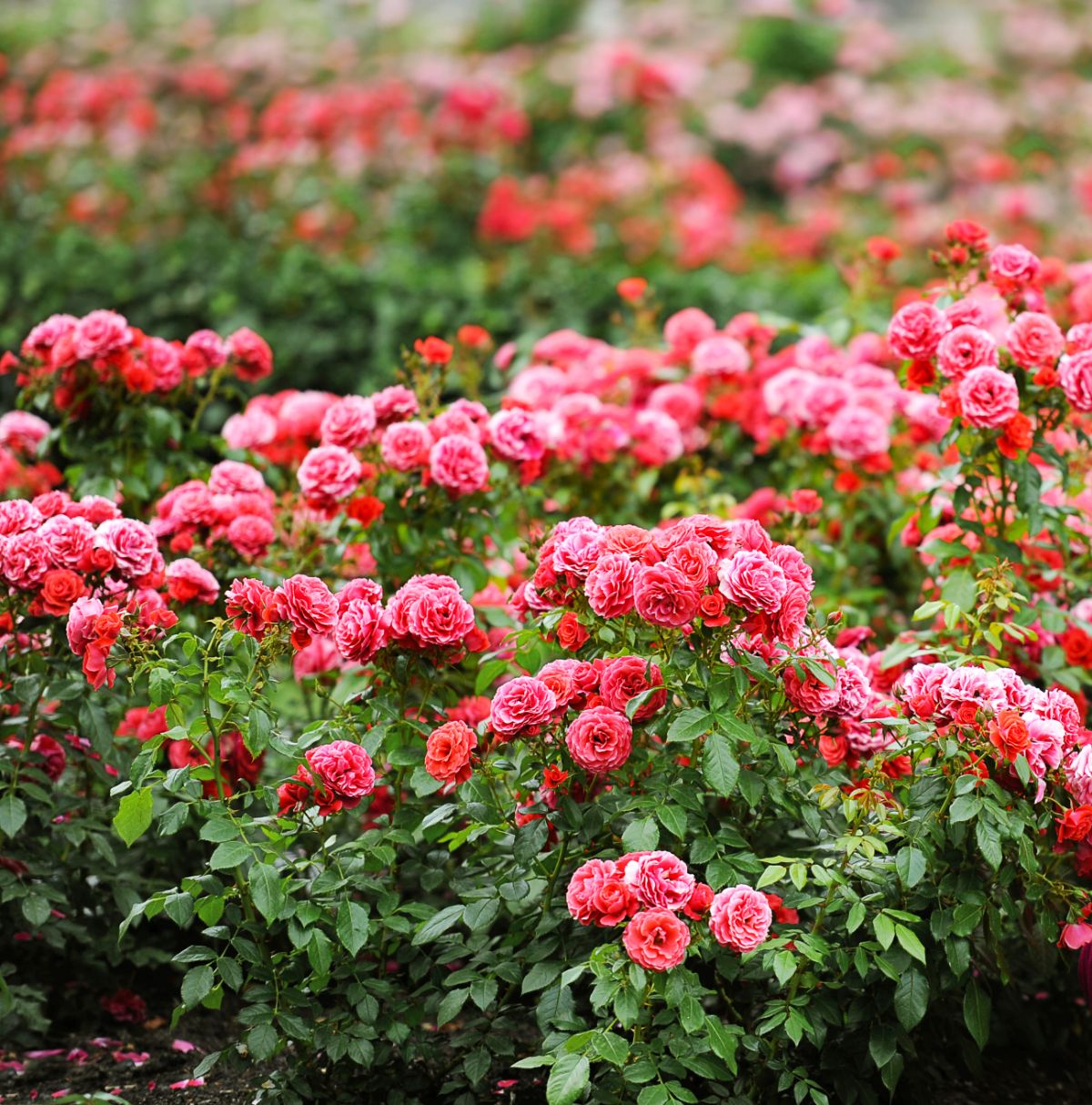
The majority of roses are native to Asia. There are some roses native to North America, Europe, and the northwestern part of Africa, however. Today, roses are cultivated widely throughout the world.
Why Grow Roses?
There are so many reasons to grow roses in your garden. Where do we start? Here are some of their benefits:
• Roses are fast-growing plants. It only takes them several years to max out their heights. Shrub roses are also large enough that they can function as effective privacy screens. So, if you are looking for a fast privacy solution for your garden, roses are an excellent answer.
• Grow roses for cut flowers. Think how much you would have to spend to buy cut roses at your local florist shop. Now you can enjoy your own all season long at no cost.
• Bring a classic, romantic look to your garden.
• Roses come in a marvelous range of colors. You will never run out of exciting cultivars to plant.
• The fragrance of roses is as wonderful as the shapes and colors of the blooms.
• These plants have excellent versatility in landscaping since they are available with a range of growth habits.
• Roses attract pollinators such as hummingbirds, bees and butterflies.
• There are numerous ways to propagate roses, making it easy to save money on future plants.
• Rose plants are not poisonous to pets, making them a safe addition to your garden.
• You can look forward to repeat blooms throughout the season from many rose cultivars.
• Roses are edible! You will enjoy harvesting the petals and the fruits for your recipes.
• Roses are lower-maintenance plants than you would expect. Even if you are a beginning gardener, you can grow them.
When Do Roses Bloom?
Depending on the cultivar, roses can bloom in spring, summer, or autumn. Some roses even bloom throughout these seasons.
How Long Do Roses Bloom?
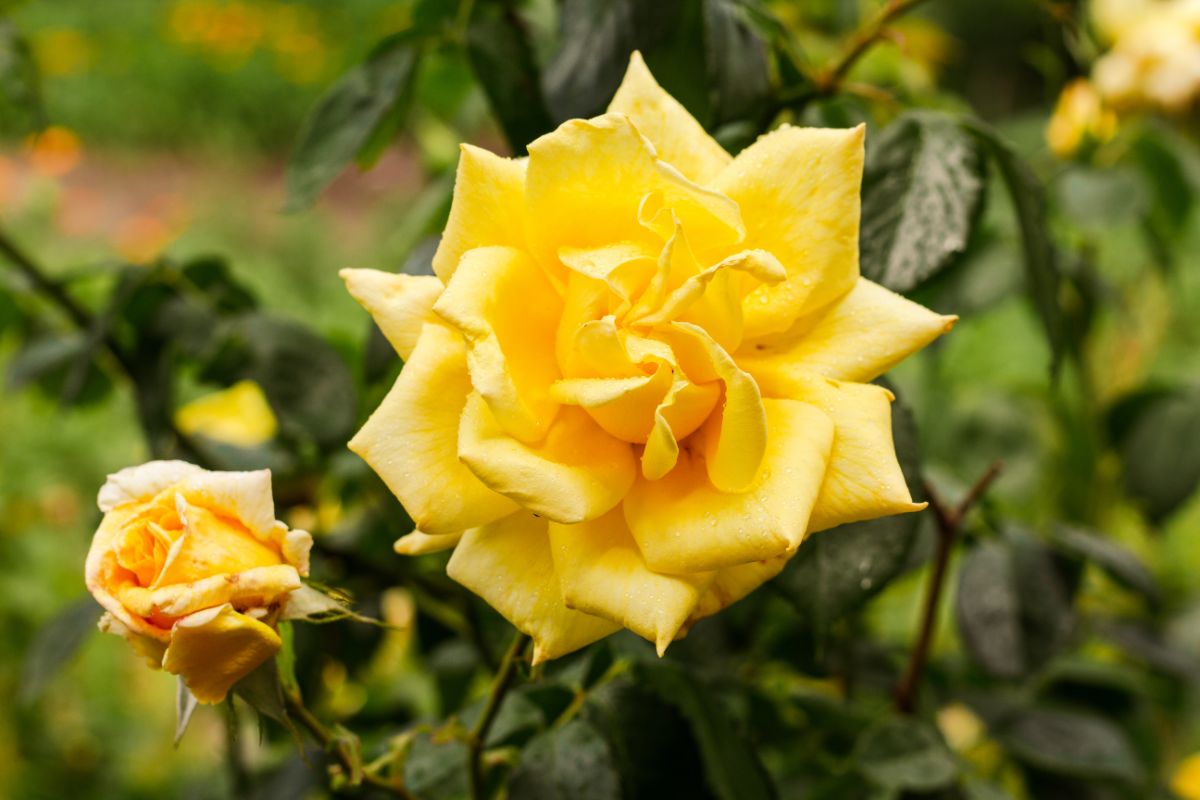
Individual roses usually last for a couple of weeks. Some types of roses only bloom once per season, but others can bloom repeatedly in cycles lasting 6-8 weeks. So, some cultivars produce months of blooms every year.
When to Plant Roses
Either plant your roses in the spring or the fall, taking care to avoid an overlap with any frost.
Ideal Growing Conditions for Roses
Let’s discuss the sun, soil, and water requirements for growing healthy roses.
How Much Sun Do Roses Need?
At least four hours of direct sunlight are needed for roses to grow at their best. They will be happiest in full sun, but some roses can tolerate partial shade.
What Type of Soil is Right for Roses?
While some plants can tolerate a wide range of soil types, roses will do best when you grow them in loamy, well-draining soil.
If you have heavy clay soil, it will not drain well enough, so you will either need to amend it or plant your roses in raised beds or containers where you can control the soil conditions better. As for sandy soils, those drains too rapidly.
The well-drained soil in which you plant your roses should have a pH range of 6-6.5.
How Much Water Do Roses Need?
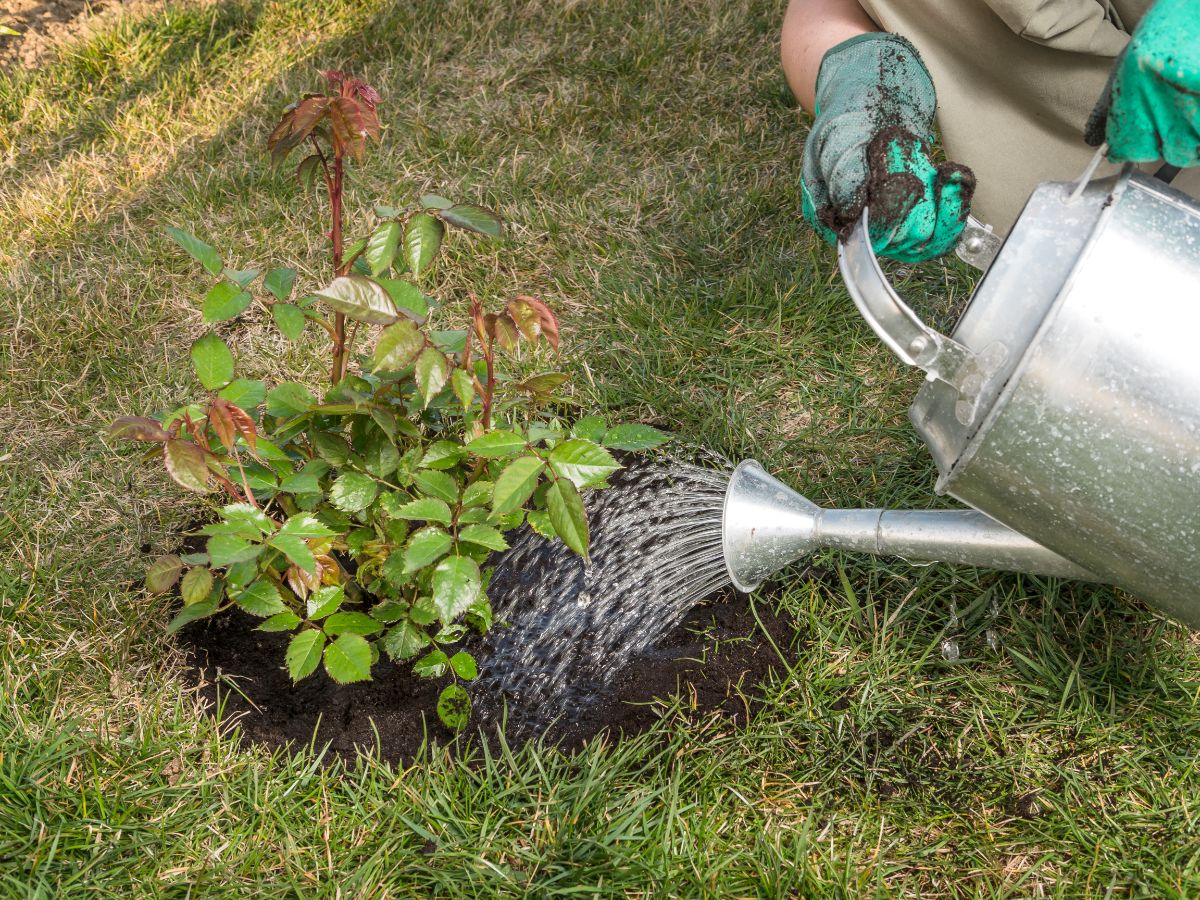
As to how much to water roses, once they are established, they will need a drink around 1-2 times weekly.
During the establishment phase, they will need to be watered more frequently than that. You will also need to water them more frequently if you plant them in pots or if the weather is hot. In fact, in particularly hot conditions, they might need water every day, even after they are established.
This resource from the Nashville Rose Society provides some useful advice and seems to suggest a more frequent watering rate in general than other sources we checked.
How to Plant Roses
How can you plant roses in your garden successfully? The process is not too tricky, though it does require care. Let’s talk about how to plant roses in your garden beds or in pots step-by-step.
Ground Planting
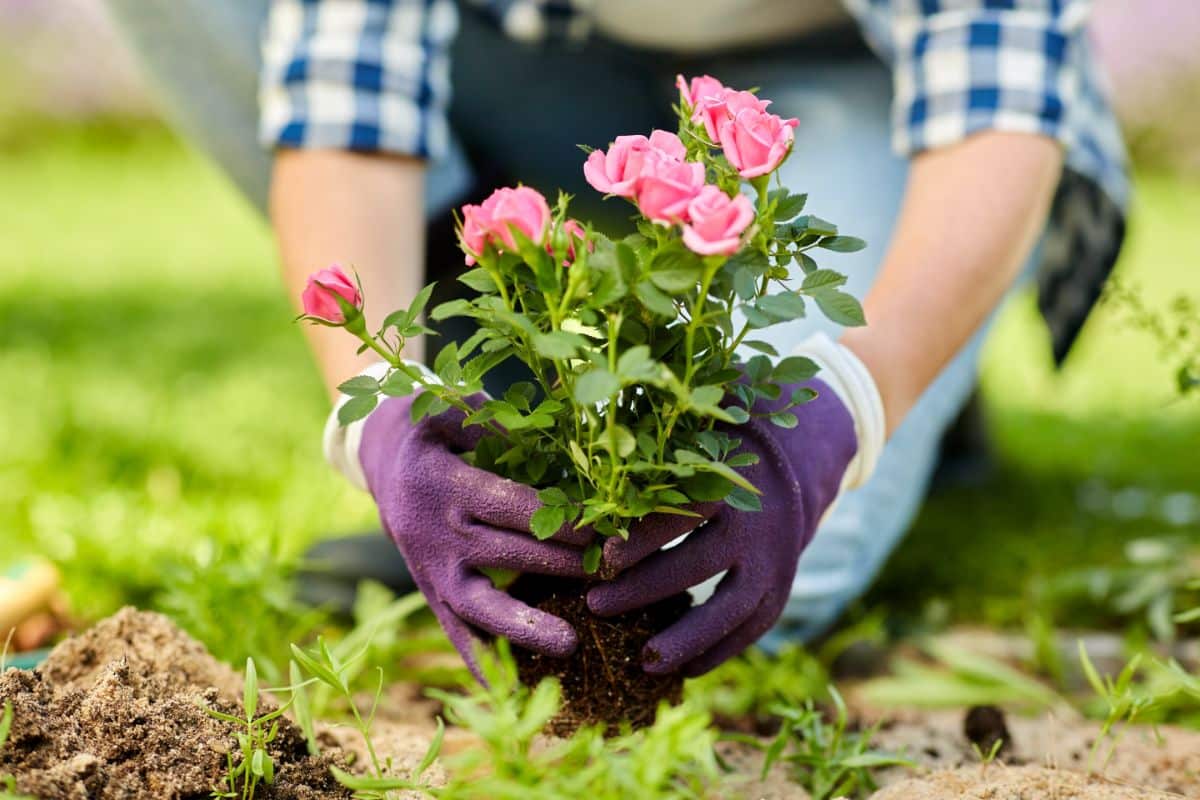
1. Pick a spot in your garden that gets plenty of sunlight and which features the loamy soil that roses love.
2. Prepare the soil before planting. Mix in compost and manure to give your roses the nutrition they need to grow. This step will also help improve the drainage of the soil.
3. Dig holes for your roses. You may need to space the plants anywhere from 24 to 36 inches apart, depending on how large your cultivars are.
4. Carefully take the roses out of their nursery containers. You may need to gently pull the roots open, as they might be tightly bound.
5. Plant the roses and backfill the soil.
6. Gently tamp down the soil, but do not compact it too much.
7. Water well.
8. Mulch immediately afterward.
Container Planting
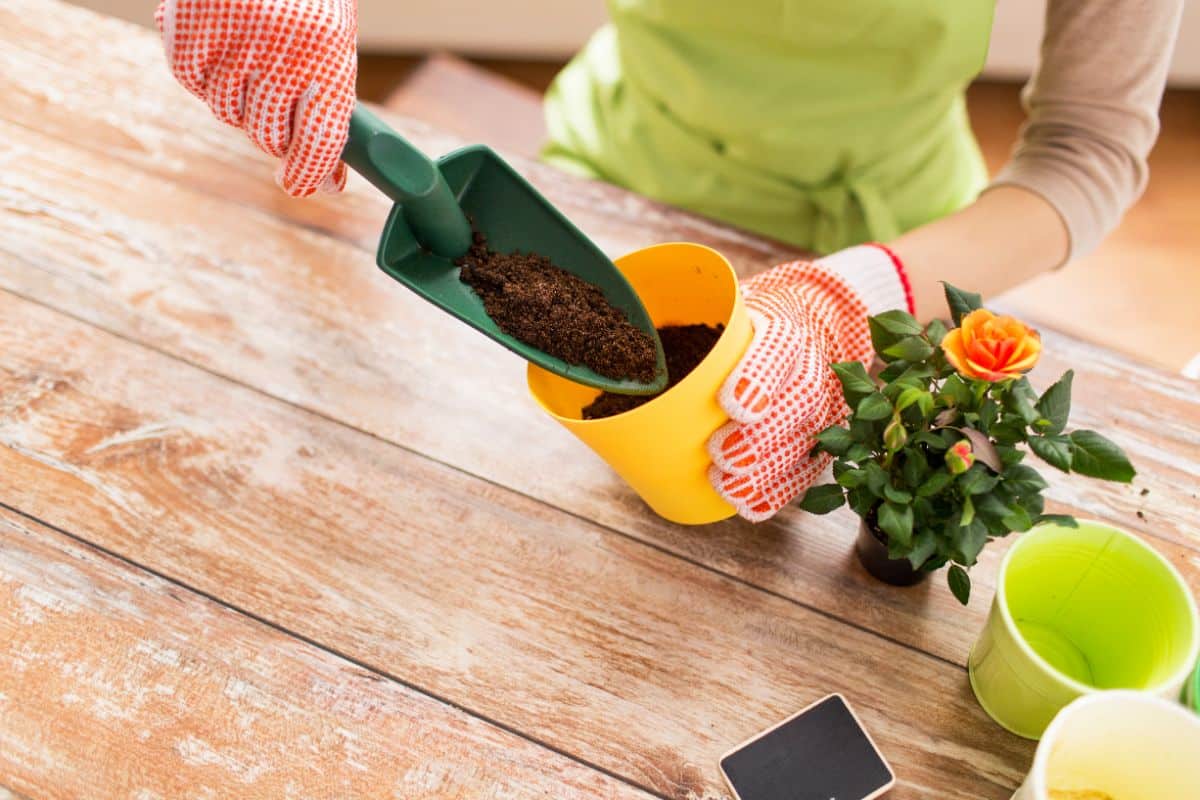
1. First, choose a type of rose that grows well in containers along with a suitable pot.
What types of roses in pots work best? Some ideas include hybrid tea roses, polyantha roses, and miniature roses.
At a minimum, the container you use should measure around 18 inches in diameter. If you are planting a bigger rose, then you might need a bigger container as well. Drainage holes, of course, are necessary.
2. To enhance drainage, put some polystyrene blocks inside the container at the bottom.
3. Fill the container partway with a mixture of compost and manure. Very gently tamp it down as you go; you do not want air pockets in your container.
4. Once you reach the halfway point, you can put the rose inside its container.
5. Finish filling in the compost-manure mixture around the plant. Keep tamping it down lightly while you work to eliminate the air pockets.
6. Water deeply.
How to Propagate Roses
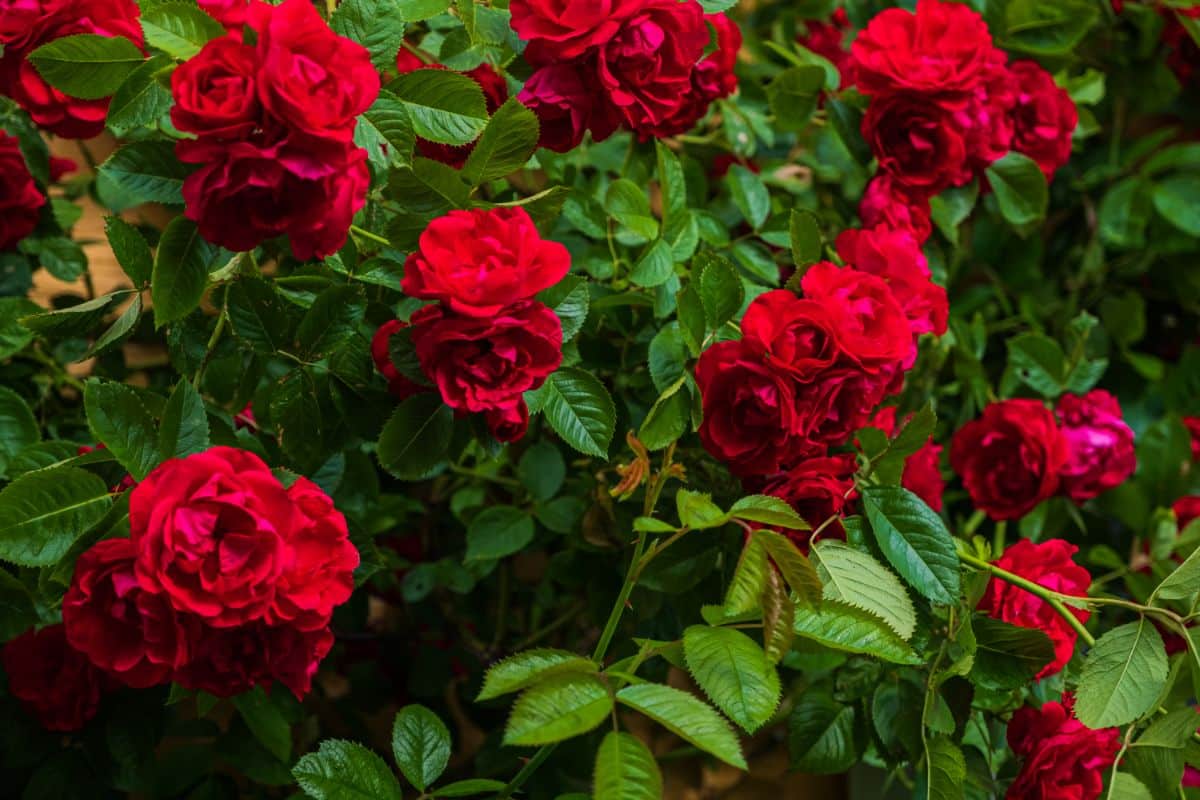
There are a variety of methods you can use to propagate your roses, including divisions, layering, grafting, seeds, cuttings, and in vitro.
Not only that but there are multiple techniques for some of these individual methods.
In this post, we will go over directions for propagation using one technique for seeds and another for cuttings. We will also explain how to divide roses.
As there are other techniques you can consider that are not in this post, you might want to do some additional research before you decide what to try.
Starting Roses from Seed
Let’s say you want to propagate the roses that are already in your garden using their seeds.
Growing roses from seeds can be rewarding, and it can help you save money on new rose plants. But you need to know before you get started that you are getting into a lengthy process that is going to require a lot of patience. Still up for it? Follow these steps:
1. First, harvest some rose hips (the fruits of the plant) and open them up to take out the seeds. Wash them.
2. Next, you are going to soak the seeds for an hour in a mixture of water and hydrogen peroxide. For a cup of water, you need half a tablespoon of peroxide.
The purpose of this step is to prepare the seeds for a long time germinating. It will help to prevent mold.
3. Next, you have to stratify the seeds. Put them in a plastic bag with a bit of damp (not wet) paper towel. Seal it, and put it in your fridge. They will need to spend two months or so in the fridge. During that time, you need to check on them periodically. Keep the paper towel damp.
4. After you are done with the cold germination process above, you still do not plant the seeds. Instead, you place them somewhere around 70 degrees Fahrenheit. Maintain the moisture, and wait another month. After that time has passed, some of the seeds should germinate successfully.
5. Now, it is finally time to plant the seeds. Fill seed trays with starter mix, and moisten it. Wait for any excess water to drain.
6. Sow the rose seeds. Since their roots are already emerging, you will have to make tiny holes for them so you can bury the roots. You will need to take care while doing this not to damage them. Once the seeds are in place, cover them with more seed starting mix.
7. Put the trays in a sunny spot where the seedlings can continue to grow. Make sure the starter mix does not dry out; using a spray bottle can help you moisten it without dislodging the seedlings.
8. Keep taking care of the seedlings while they are developing. Eventually, they will get true leaves. They are now ready to transplant into larger containers.
9. Once you have moved the seedlings to bigger containers, keep them indoors for the next year.
10. Harden the seedlings once you are finally ready to transplant them outdoors. Take them outdoors for a short time, then bring them back in. Take them out for longer, then bring them in again. Keep doing this until they have gotten used to life outdoors. Then, transplant them into your garden beds.
Starting Roses from Cuttings
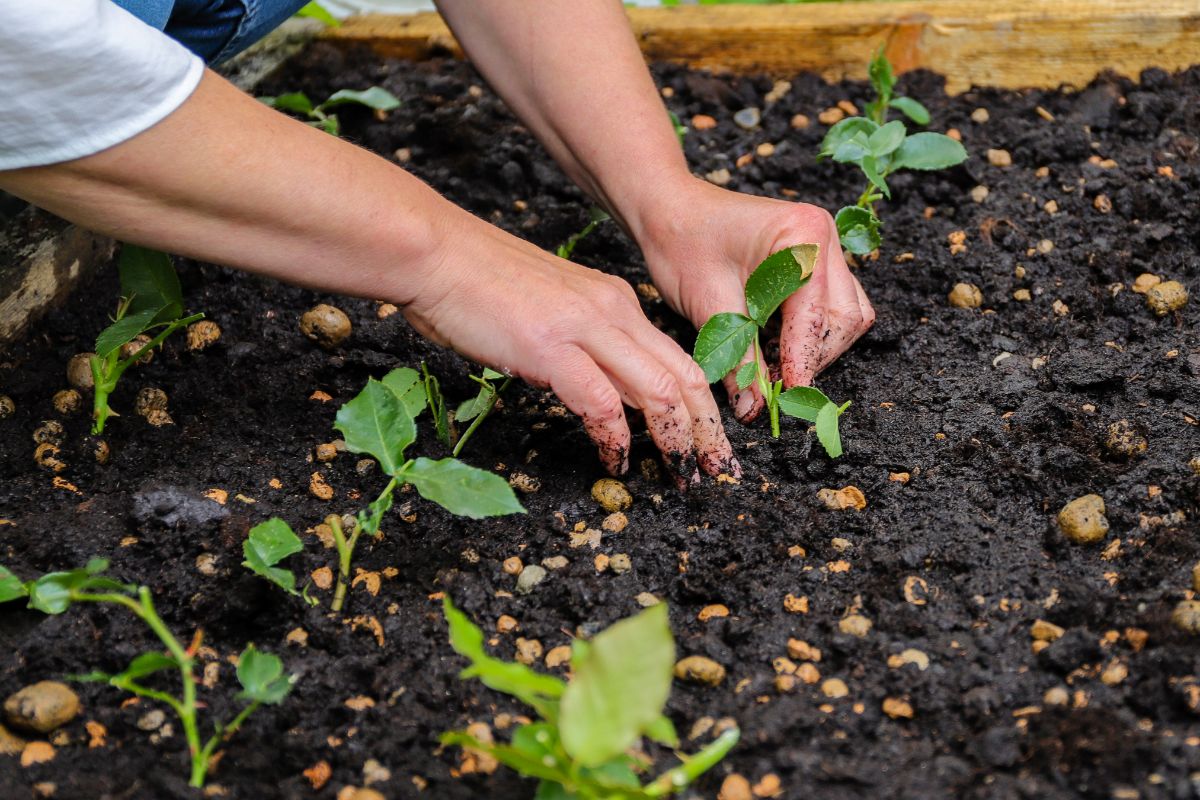
You can start roses from cuttings in water or soil. Some people even say you can grow roses from cuttings in potatoes, though there are mixed reports as to whether that works or not. Below are the instructions for starting roses from cuttings in water.
1. During summer, take cuttings that measure 4-6 inches. Cut just below the leaf nodes.
2. Remove flowers and buds from the cuttings, along with all of the leaves except the top two.
3. Fill a glass or jar with water and put the cutting inside. Do not place the leaves below the surface of the water.
4. Find a sunny spot for your cuttings, but keep the light indirect.
5. Wait for the roots to develop, which can take up to 4 weeks. You will need to refresh the water periodically.
6. After the new plant is sufficiently rooted, you can transplant it into a container with soil. Water it and leave it in the same spot with indirect sunlight.
7. The plant will need to live in your house until the following spring. You can then harden it and transplant it outside.
How to Divide Roses
We see mixed claims over whether you can or cannot divide roses, so it seems to depend on the type of rose you have.
Here is a page on the University of Arizona Cochise County Master Gardeners website that confirms that at least some types of roses can be divided—in this case, miniature roses.
The site explains, “Most miniature roses grow on their own roots instead of being grafted onto a different rootstock. So, while it is not often done, it is usually quite easy to increase the number of your plants by division just as you would with chrysanthemums, daylilies, etc.”
Here are the steps:
1. Check if there are multiple basal stems for the bush. If there are, you can proceed.
2. Dig in a circle around the plant and then push under it with a shovel to remove it from the ground. If it is in a container, simply remove it from the pot.
3. Wipe away the excess dirt to help you see what you are doing.
4. Use a sanitized knife to divide the rose.
5. If you find any broken roots, remove them. Then, trim back the tops.
6. Dig holes or get new containers for the divided rose plants.
7. Transplant your divided plants, backfill the soil and water well.
That wraps it up; as you can see, it is pretty similar to dividing other types of perennials. Just make sure you check that you are dividing a type of rose that you can divide before you attempt to get started.
How to Care for Roses
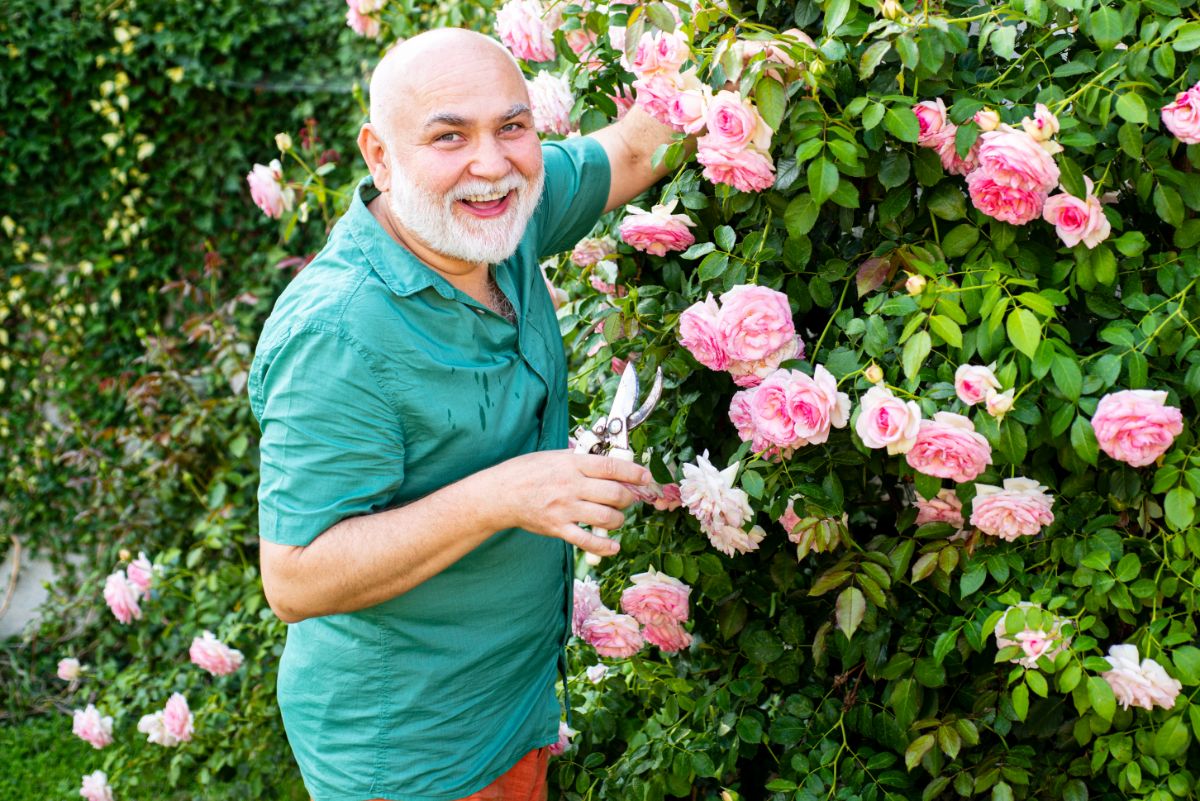
Below, we go over what you need to know about fertilizing, mulching, staking, and pruning roses. Some types of roses are easier to maintain than others; you can look into this when you are considering what cultivars to choose. Make sure you are picking something that is suitable for your skill level and the time you have to invest.
How to Fertilize Roses
Roses do need to be fertilized, but you have to be cautious when you are doing it. Clemson Cooperative Extension Home & Garden Information Center explains, “When fertilizing newly planted bare root plants, care must be taken not to burn the new roots. Apply organic amendments to the soil at planting time, but wait until after the plant has produced its first blooms to apply chemical fertilizers.”
Watering well after fertilizer applications can help to prevent root burn.
The site continues, “For best performance, fertilize when the plant first leafs out and repeat after each flush of bloom until six weeks before the earliest frost date for your area … Reduce the amount of fertilizer applied during June, July, and August by half but continue to feed after each bloom cycle.”
What types of fertilizer are suitable? There are fertilizers made specifically for roses. They also can respond well to manure.
How to Mulch Roses
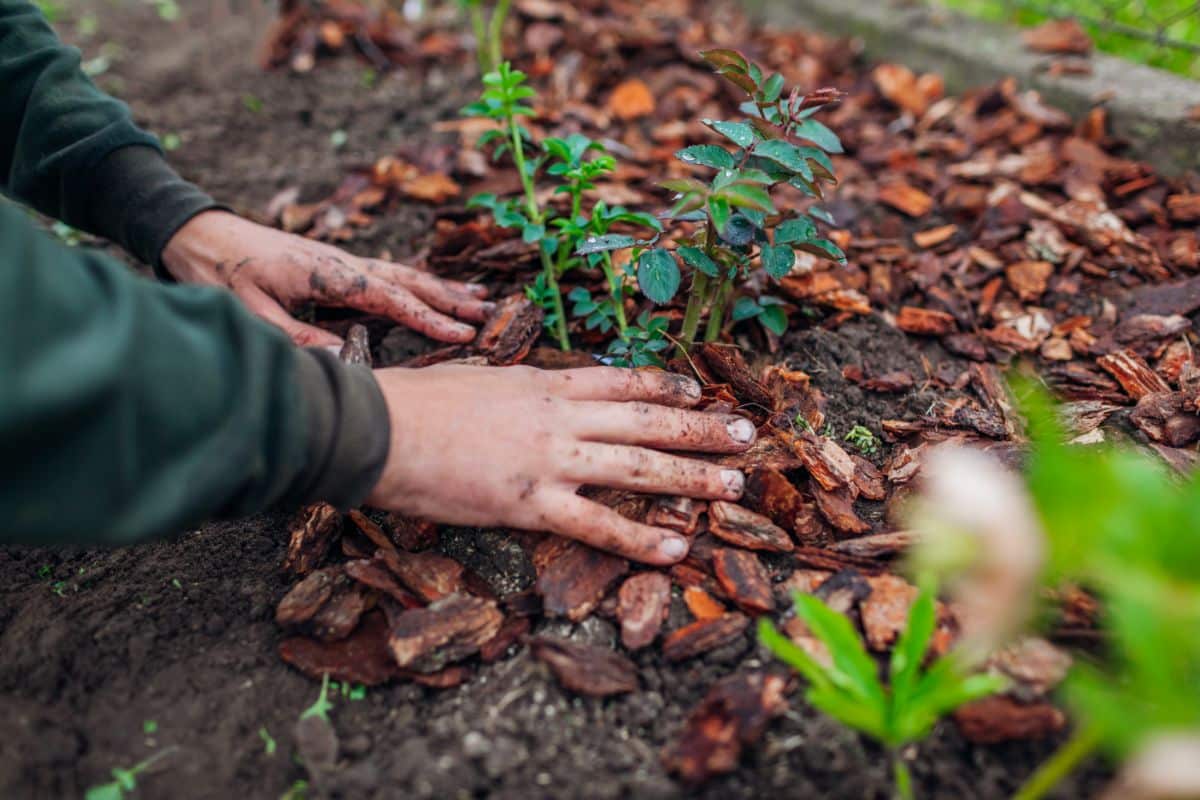
Mulching your roses is a good way to protect them from weeds. It also helps keep the soil from drying out. Around 3 inches of wood chips, leaves, pine bark or pine straw should do the trick.
It is important to leave a little space around the rose shrub’s stem. If you pile the mulch against it, the stem cannot breathe, and rot may set in.
How to Stake Roses
The best way to stake a rose depends on what type of rose plant you have. If it is a climbing or rambling cultivar, you can set up a trellis or arbor for it.
For other types of roses, you can use sturdy stakes and tree ties to keep your plants upright.
How to Prune Roses
Pruning your rose plants involves deadheading and trimming. You might actually be surprised by how simple and straightforward it is.
How to Deadhead Roses
You can deadhead your roses if you want to prevent them from going to seed or encourage them to produce new flushes of blooms (for re-blooming varieties).
• If you have a type of rose that produces just one flower per stem, trim off the wilting bloom and the top set of leaflets.
• For types of roses that produce clusters, use your shears to remove the whole cluster.
• If you have Knock Out roses or some other types of shrub roses, the plants may drop their wilted flowers without any help from you. Deadheading is unnecessary.
When to Cut Back Roses
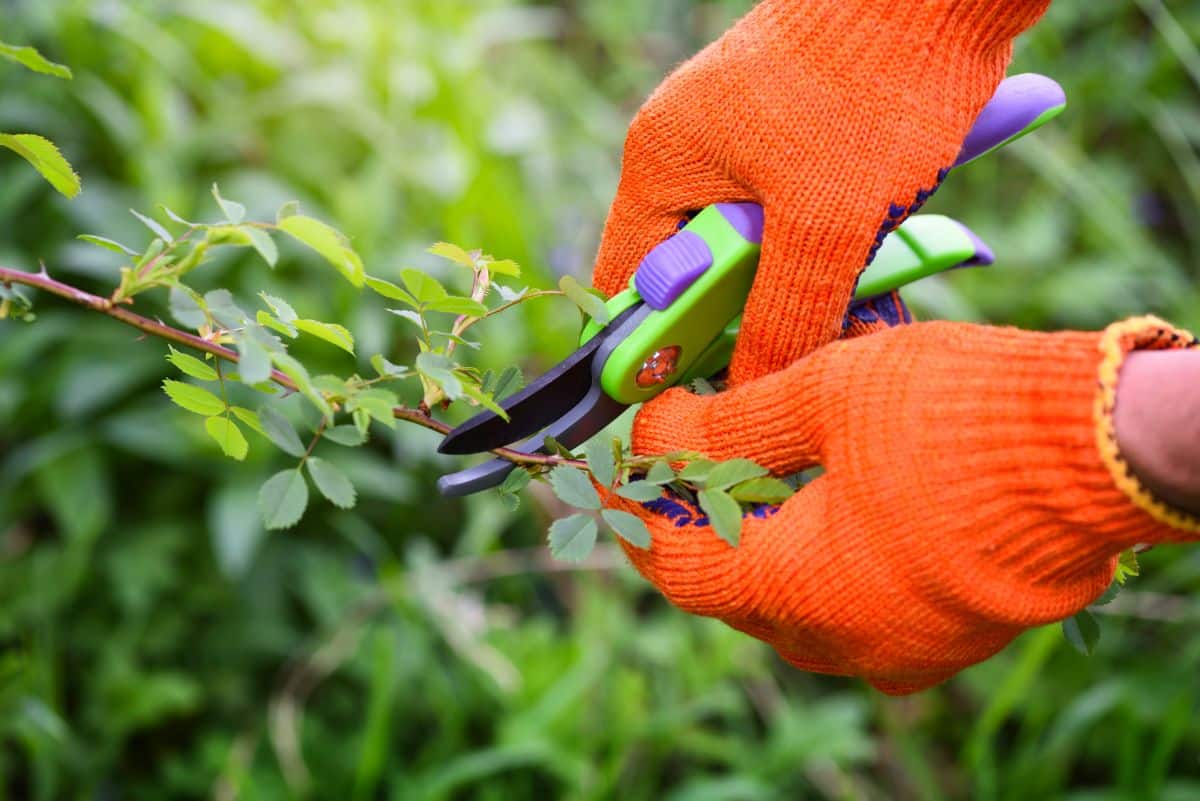
Do a little pruning in springtime to get rid of dead canes and/or shape your shrubs.
While a lot of perennials need some autumn pruning, roses are not among them. In fact, it can cause problems for many types of roses because it prevents the plants from entering dormancy at the appropriate time.
This is important to keep in mind if you routinely cut flowers for arrangements. Doing this too close to the first frost of the season can be harmful to your roses.
There are a couple of exceptions, however. In autumn, you should cut the tops of grandiflora and hybrid tea roses so that they are not standing taller than 4 feet. Doing so helps keep the wind from grabbing them and causing damage in winter. The technical name for this activity is “heading back.”
Are Roses Vulnerable to Diseases or Pests?
Roses are often easy to care for, but there are a number of diseases they can be susceptible to. Some of these include:
• Black spot
• Powdery mildew
• Downy mildew
• Botrytis blight
• Canker
• Rust
• Crown gall
The Connecticut Agricultural Experiment Station at Connecticut State provides detailed information on all of these possible roses diseases. The site recommends, “Many rose diseases can be effectively avoided or minimized through the combined use of culture, sanitation, resistance, biologicals, and pesticide sprays. For example, there is renewed interest in the old garden roses because of their resistance to many diseases and their winter-hardiness.”
A number of insect pests can cause problems for roses:
• If you notice yellowing or stippled leaves, the culprits might be spider mites or rose leafhoppers.
• If the blooms are disclored or shaped wrong, thrips could be at fault.
• Are the canes dying back? Some insects that cause this problem include raspberry horntail larvae, flatheaded borers, and scale insects.
• If something appears to be eating the roses, some possibilities include fuller rose beetles, hoplia beetles, roseslugs (a type of sawfly), caterpillars, leafcutting bees, or rose curculio (a kind of weevil).
Some other insects that cause issues for roses include rose midges, mossy rose galls, lady beetles, minute pirate bugs, lacewings, syrphid flies, soldier beetles, and predaceous mites. Certain spiders can be problematic as well.
If you want to learn about all of these pests in-depth, take a look at this excellent resource from the University of California.
You are probably wondering whether slugs (true slugs, not just sawfly caterpillars) and snails eat roses. The answer, unfortunately, is yes. Watch out for slugs and snails, and remove them from the area around your roses when you spot them.
Alas, roses also are a favorite delicacy among deer and rabbits, so mammals in your area could also be a bit problematic. You might need to take some precautions to fence off access to the parts of your garden where you plant your roses.
Recommended Planting Combinations for Rose
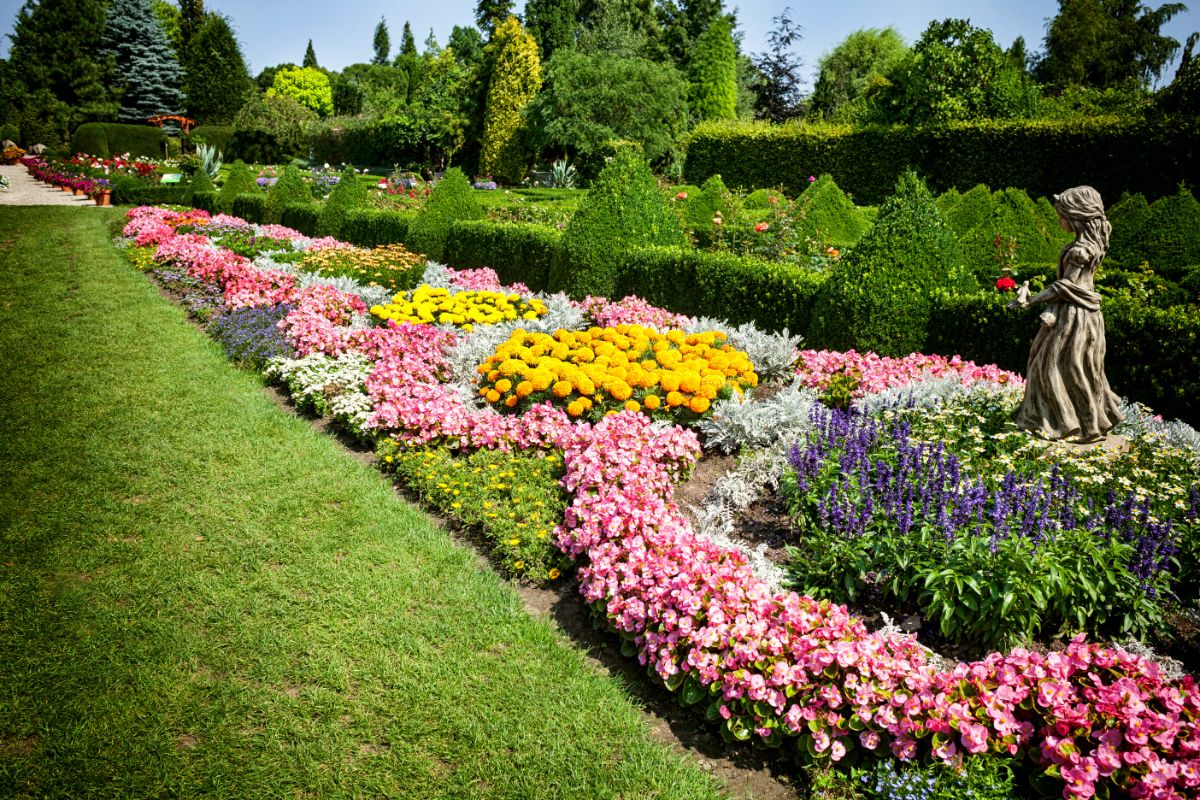
Here are some ideas for plants that go nicely with roses:
• Marigolds flourish in similar conditions as roses, and can make for a sunny accompaniment to your rose bushes.
• Everlasting sweet peas: These plants love sunlight, and are another “classic” flowering plant like roses. They complement each other magnificently.
• True lilies: Planting a sturdy rose shrub near true lilies can provide the lilies with some much-needed support, reducing the need for stakes.
Those are just several examples. Roses make excellent companions for a broad range of garden favorites.
Rose Landscaping Ideas
Roses are among the most versatile perennials for your landscaping, thanks to their various growth habits. So let your imagination run wild. Here are some ideas for how you can give your landscaping a romantic touch by planting roses.
• Hedges: Roses that grow as shrubs make excellent hedges that, in turn, can be used as borders or even privacy screens. Use them to shape your landscape and increase the seclusion in your garden.
• Container gardens: Tea roses work particularly well in pots and can thrive on your patio or anywhere in your outdoor spaces.
• Formal gardens: Roses are one of the defining elements of traditional English formal gardens. If you want your own garden to resemble one of these lovely cultivated landscapes, planting some roses can help you achieve the look.
• Cottage gardens: Another look that roses can help you capture is the “overgrown” abundance of a classic cottage garden.
• Arbor: Climbing roses can be trained to cover an arbor, which you can use as a focal point or gateway in your garden. This is one of the most dramatic and eye-catching uses for roses in your landscape.
• Up a wall: If you set trellises up against your wall, you can grow climbing roses up them. If they will be placed near windows, be sure to choose some particularly fragrant cultivars so you can enjoy their scent from inside when you open the windows. This is also a good tip for choosing what to grow in a container garden on your patio.
• Over a fence: One more idea for how you can use climbing roses in your landscape is to grow them over a fence.
Recommended Rose Varieties
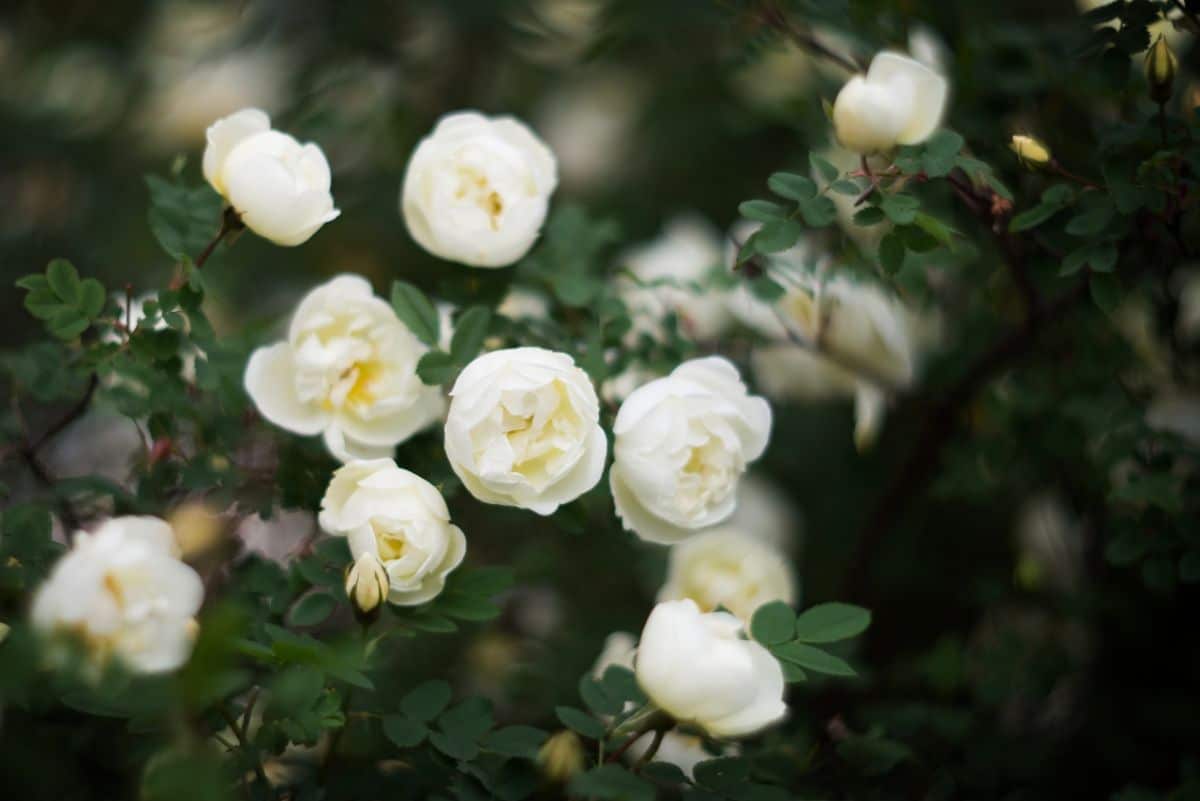
We could easily create an entire article (or several) exploring the numerous varieties and cultivars of these beautiful blooms. As that is a bit beyond our scope, let’s at least take a look at a few stunning cultivars to add to your garden.
• Double Easy Orange Floribunda: Each of these beautiful flowers unfolds as many as 60 petals, making for a breathtaking sight. Their orange hue will warm your garden from spring through fall.
• About Face Grandiflora: Another rose to plant for vibrant orange hues is “About Face.” When you smell these fragrant roses, you might find yourself thinking of apples; you will be surprised how similar they smell! Another advantage of this cultivar is its disease resistance.
• Enchanted Evening Floribunda: These roses have a classic shape and a lovely lavender hue.
• Bonica: Another of our favorite roses is this cultivar that produces sprays of blooms in pale pink. If you need something for a cooler climate zone (even down to zone 4), “Bonica” may be perfect for your garden.
• Falstaff: These beautiful roses sport distinctive blooms that are densely packed with deep red flowers. It has a lovely scent and is a fantastic English rose for your garden.
• Mardi Gras: The flower color of these stunning roses is deep orangey pink, getting lighter toward the center. A hint of yellow gives the impression of a warm glow from within the blooms.
• Wild Blue Yonder: For beautiful garden roses that feature a deep pinkish-purplish color, plant these beauties. Do not be fooled by the name, however—there are no true blue roses.
• Cherry Parfait: Add some sweetness to your flower garden with “Cherry Parfait,” an eye-catching cultivar featuring blooms that are white with red around the edges.
• Larger Than Life: If what you want in your garden is huge yellow blooms, you will welcome the sunny hues of “Larger Than Life.” This is a relatively new type of hybrid tea rose featuring up to 95 petals per bloom.
• Black Baccara: You won’t bring any scent to your garden when you plant this cultivar, but you will appreciate it spectacular deep reddish-blackish petals.
• Black Magic: These roses are an incredibly deep burgundy hue that is very close to black.
• Winchester Cathedral: With a name as majestic as this, you know this cultivar is going to blow you away. The ruffled flowers are white and have an exquisite fragrance.
• White Parfum de Provence: This, of course, is another white rose. As a tea rose, its flowers have a classic look and are ideal for arrangements and bouquets. It produces an appealing fragrance.
• Green Romantica: While roses may not come in blue, they do come in a pale green color. This cultivar’s double blooms are a captivating hue which is only matched by its delightful scent.
• Rosa Glauca: If you are looking for something a little bit different for your garden, you might want to pick up this cultivar of wild rose. The blooms are appealing in their simplicity and feature petals that are white toward the centers and pink toward the tips. The centers themselves are a cheerful yellow. It is attractive to pollinators and is also a winner of the Award of Garden Merit from the Royal Horticultural Society.
• Pomponella: The vibrant pink blooms of this cultivar feature a distinctive cupped shape for an unusual effect in your garden.
These are just a few examples of the numerous varieties of roses you can plant to bring romance and elegance to your garden.
Frequently Asked Questions About Growing Roses
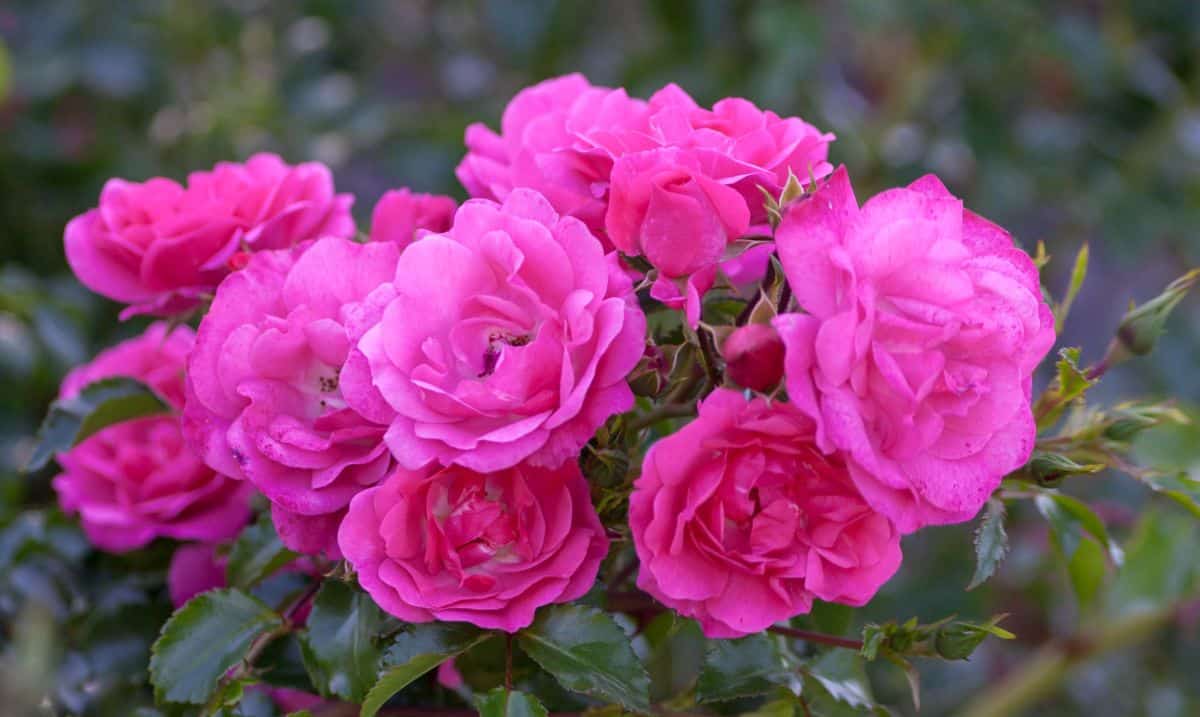
Let’s answer some frequently asked questions about roses. We’ll go a bit deeper with this FAQ than we usually do, simply because this is such an iconic flower, and you may have many questions about it.
Many different insects eat roses, and so do spiders, slugs, snails, deer, and rabbits. It may be tricky to pin down the culprit if you do not catch them in the act.
Roses are non-toxic to cats, dogs, and horses.
Yes, roses are angiosperm plants. In short, they produce fruits which contain seeds. Those fruits are called rose hips (also spelled “rosehip”). Sometimes they are also referred to as rose heps or rose haws.
Rose hips may be orange, red, purple, or black. They start showing up as early as spring, but it isn’t until later in summer or fall that they become ripe (see below). Their bright colors give them an appealing appearance, to the point where some cultivars actually are popular in part for the appearance of their rose hips.
Yes, you can indeed eat rose hips. If you want to eat them raw, be careful—there are some hairs in them that produce an unpleasant sensation (to the point of being an ingredient in itching powder), so you will want to get rid of them before you bite into the rose hips.
Rose hips can be used as an ingredient in soups, teas, alcoholic beverages, breads, jams, syrups, and more.
What do rose hips taste like? Some other fruits they are sometimes compared to include tart apples, plums, and cranberries.
If you are looking for a flavor that is more sweet and less tart, you will be delighted to learn that you can also eat the petals of your roses. This is true no matter what species of rose you plant.
You may munch on the petals on your own, add them to a salad, or use them in recipes for jams, teas, alcoholic beverages, or desserts.
A particularly famous dessert that is often flavored with rose is Turkish delight. The best-known reference to this dessert in popular culture is in C.S. Lewis’ book The Lion, the Witch and the Wardrobe, wherein the character Edmund is tempted into turning on his siblings by an offer of Turkish delight by the book’s villain, the White Witch.
It is hard for any dessert to live up to the high expectations that a reader might have—and frankly, most report upon trying Turkish delight that they don’t understand how it was enough to win over Edmund.
That said, it is still pretty good and showcases the sweet floral taste of rose petals at their finest.
Rose plants can vary considerably in terms of their life spans. At the lower end, some roses might only live for about six years. At the upper end, some types can live for more than half a century.
No, roses do not have invasive roots.
Yes, roses have “thorns,” though not exactly. They have something called “prickles.”
As explained here, “Interestingly, rose thorns are not actually thorns. “Thorn” is used to describe a plant with branches modified for physical defense. Because the pointy projections of a rose bush are modified epidermal cells (similar to skin cells in humans), roses do not have thorns; they have prickles.”
We see a lot of people asking, “Do roses grow well in Florida?” or “Do roses grow well in Texas?” or some other state.
Since there are roses available for a wide range of climate zones, no matter where you live, you should be able to find something suitable.
Just look up the climate zone for the species you are thinking about planting to make sure it is right for your area.
Roses are perennial plants that bloom year after year.
Where to Buy Roses
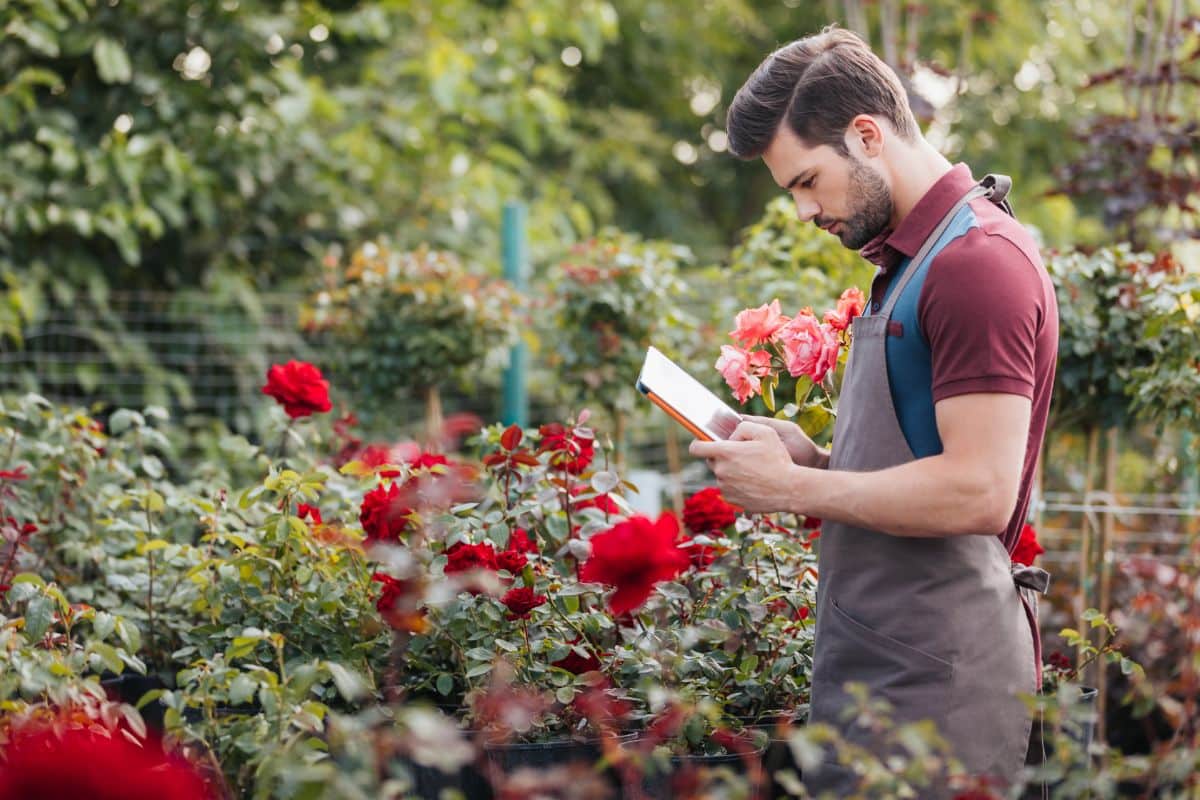
The romance and splendor of roses awaits you—and now you know how you can grow these captivating perennials in your own garden. To browse the largest collection of rose cultivars, shop for roses online.

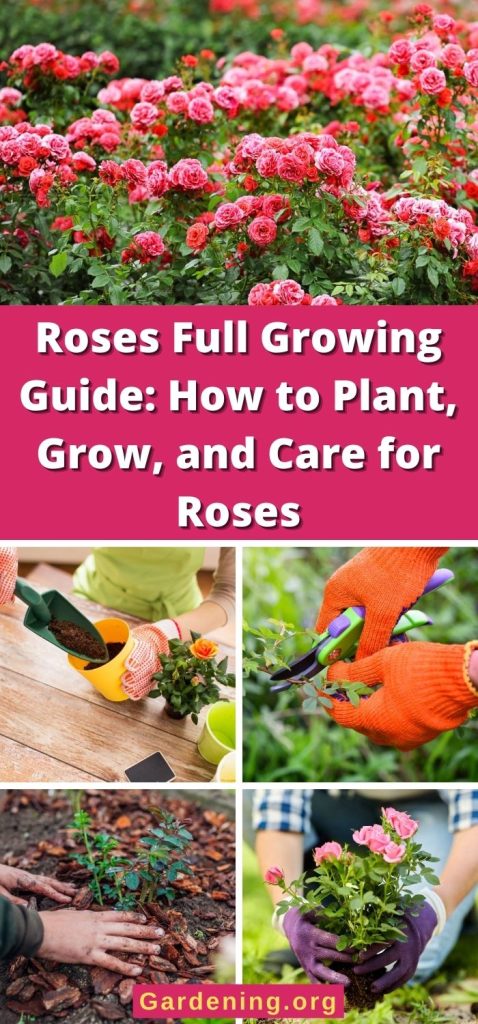
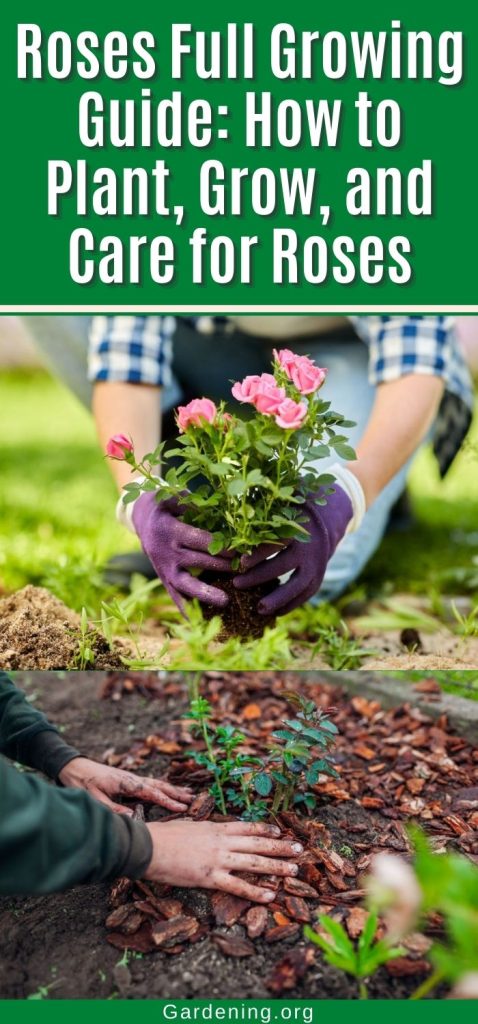
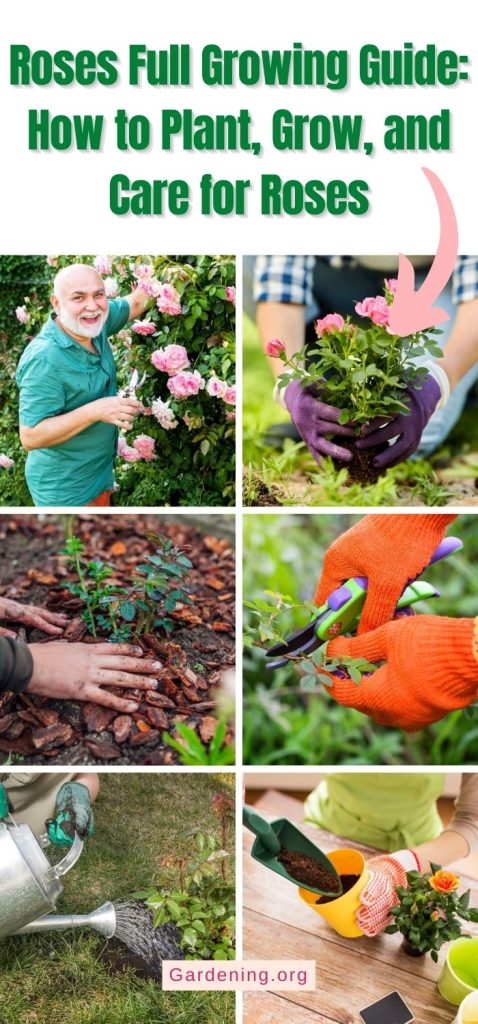
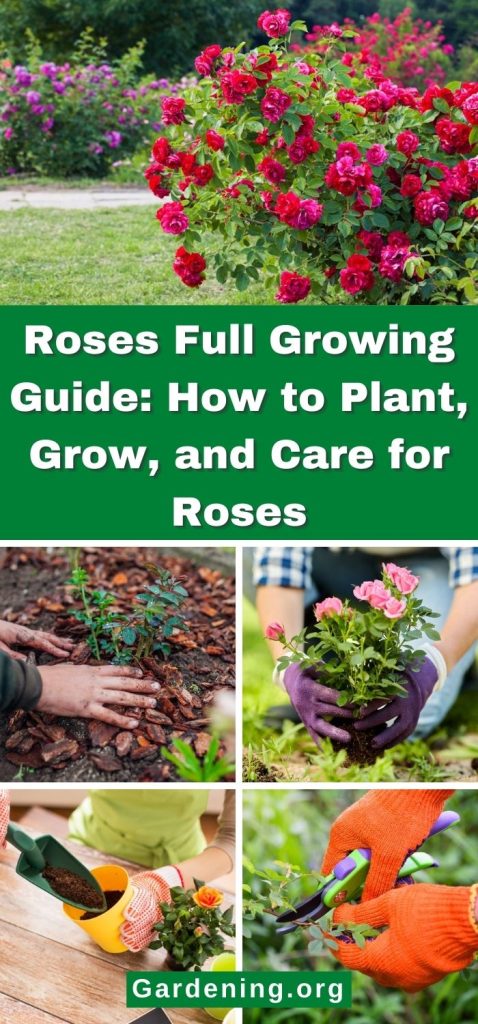




Leave a Reply